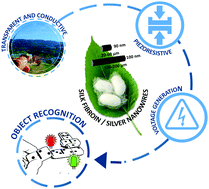Optically transparent silk fibroin/silver nanowire composites for piezoresistive sensing and object recognitions†
Abstract
This work focuses on the development of a novel generation of bio-based advanced multifunctional materials, able to replace the synthetic ones and thus contributing to sustainability. Silk Fibroin (SF), a protein obtained from Bombyx mori cocoons, has been selected due to its natural accessibility, physico-chemical properties and facile processability. In order to extend its functionality, SF was combined with silver nanowires (SNW) to develop SF/SNW nanocomposites. The effect of the filler aspect ratio and concentration on the SF microstructure, and thermal and dielectric properties has been addressed. It is shown that the inclusion of the conductive fillers allows tailoring of the SF/SNW nanocomposites’ electrical properties, while maintaining SF intrinsic flexibility and thermal stability. Optical transparency is maintained for the lower filler concentrations. Furthermore, the SF/SNW nanocomposites show piezoresistive characteristics suitable for the development of force and deformation sensors. Furthermore, the ability of the samples to generate electricity (electric potential difference between 30 to 124 mV, which increases with SNW content) was used for the design of an object recognition device. Overall, the work demonstrates the multifunctional properties of SF/SNW nanocomposites for a variety of applications and, therefore, their suitability as advanced sustainable materials for a new generation of devices.



 Please wait while we load your content...
Please wait while we load your content...